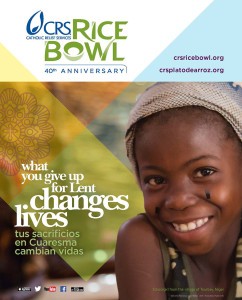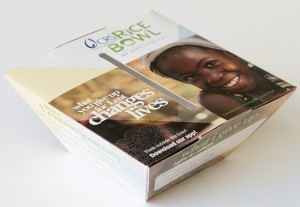 Catholic Relief Services marks 40th year of Lenten fundraiser
Catholic Relief Services marks 40th year of Lenten fundraiser
Catholic Relief Services in 2015 marks the 40th anniversary of CRS Rice Bowl, the largest and oldest Lenten program used by millions of Catholics across the United States.
Known for its iconic and symbolic cardboard “rice bowl,” the program has evolved over multiple generations to become a tradition for Catholic families, parishes and religious educators. Since its inception, millions of Catholics have contributed alms totaling $250 million to support efforts that fight poverty and hunger in dioceses across the U.S. and overseas.
“When we step back and consider that this paper rice bowl has made it possible to give real, life-saving assistance to so many, we see the power the 40 days of Lent have produced over the last four decades,” said Joan Rosenhauer, executive vice president of U.S. operations for Catholic Relief Services (CRS). “It’s the right time to step forward and fill each rice bowl with $40 and make a lasting change for those who need our help.”
Pope Francis has captured the world’s attention to the plight of hunger and poverty around the world. He said, “the scandal that millions of people suffer from hunger must not paralyze us, but push each and every one of us to act: singles, families, communities, institutions, governments, to eliminate this injustice.” People looking for a way to respond to this call will find CRS Rice Bowl is a proven and robust response.
For people like Thomas Awiapo from Ghana, the power of CRS Rice Bowl is quite tangible. His destiny was altered as a young and hungry orphan – who lost two brothers to starvation – when he was welcomed into a school where lunch, funded through CRS Rice Bowl, was served.
“You can call me the poster child for CRS Rice Bowl but we’d be closer to the truth if you called my children your poster children. They have never experienced hunger in their lifetime, and today they attend university, high school and secondary schools without missing a beat,” Mr. Awiapo said.
He is speaking in dioceses around the country through March.
Begun in 1975 in Allentown, Pa., as a response to the famine in the African Sahel region, the idea took hold and was adopted by U.S. bishops as a national response to hunger around the world. A year later, the initiative became an official program of CRS as “Operation Rice Bowl.” Known today as CRS Rice Bowl, the program uses donations to support CRS’ humanitarian programs in 93 countries overseas, providing life-saving assistance and hope to impoverished and vulnerable communities. Twenty-five percent of the total contributions remain in the dioceses where they were given and often fund food pantries, community gardens and outreach to vulnerable populations in the United States.
The look and feel of the program has evolved over time and today incorporates a wide variety of resources for people – at any age – to make Lent a deeper and more fulfilling experience. In addition to a full collection of resources for educators, parish leaders and parents, there is a CRS Rice Bowl app for people to use on their mobile devices.
“The app helps make Lent a daily experience within the hustle and bustle of modern life,” Ms. Rosenhauer said. “It can be personalized to help keep your Lenten goals – whether it’s deeper prayer, greater learning about your brothers and sisters around the world, or sticking to a plan to give up coffee and turn a latte into sacrificial giving. Last year people raved about its debut. This year it’s even better with built-in social media, a full collection of our best videos and it is also available in Spanish.”
For the 40th anniversary, the program offers two new video series along with a video made especially for young children. The popular “CRS Global Kitchen” video features Father Leo Patalinghug, host of GracebeforeMeals.com, who cooks five meatless recipes from this year’s recipe collection. The dishes are from the countries featured in the “Stories of Hope” collection available each week during Lent. This year’s recipe collection features:
• Ugali with bean soup from Tanzania;
• Gallo Pinto from Nicaragua;
• West African peanut stew from Niger;
• Fattet laban from Lebanon;
• Fried plantains and beans from the Democratic Republic of Congo.
Another series, called “What is Lent?,” features eight prominent Catholic figures who answer the question “What is Lent?” Between them, they illuminate topics such as prayer, fasting, almsgiving, and solidarity to show how these practices are foundational to the Lenten season. Featured for 2015 are:
• Cardinal Timothy Dolan from the Archdiocese of New York explores Lent as a journey;
• Los Angles’ Archbishop José Gomez speaks about Solidarity;
• CRS Board Chairman and Oklahoma’s Archbishop Paul Coakley covers the core foundations of Lent;
• Father James Martin, SJ, shares his approach to prayer;
• Kerry Weber talks about mercy;
• Author and speaker Christopher West provides insight on the topic of Lenten fasting;
• Writer and professor Ron Hansen talks about almsgiving;
• CRS president and CEO Carolyn Woo examines the practice of Lent.
CRS Rice Bowl materials are available in English and Spanish in print, on the web and through the mobile app. To follow CRS Rice Bowl on Twitter or Facebook, search @CRSRiceBowl or #4Lent4Life.
To donate and to learn more about CRS Rice Bowl, visit crsricebowl.org or download the app from the iTune or Google Play stores.
Catholic Relief Services is the official international humanitarian agency of the Catholic community in the United States. The agency alleviates suffering and provides assistance to people in need in 93 countries, without regard to race, religion or nationality. For more information, visit www.crs.org or www.crsespanol.org.
